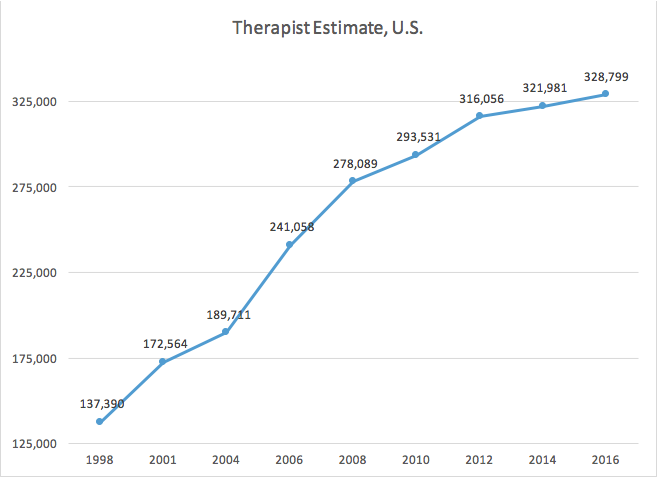There are 328,799 massage therapists in the United States as of June 2016. That’s our story, and we’re sticking to it.
ABMP prepares a massage therapist population estimate every two years. In its first incarnation in 1998, the population estimate was more like a S.W.A.G. (look it up), but as regulation of the massage field became more widespread throughout the 90s and 00s, more concrete data appeared. With 45 states now regulating the practice of massage, the fact-gathering has become easier and more reliable. Here is a look at our estimates since 1998:

Based on our data, the size of the massage field has increased nearly 140 percent since 1998. While valuable to examine the long view to see how the field has grown, the most pertinent information taken from this year’s estimate is that the number of massage therapists is still actually growing. From what is heard in the field—and in particular through franchise massage retail establishments—there is a considerable dearth of massage therapists available for hire. The growth of the field has slowed considerably—as evidenced by the reduction in the number of graduates from massage programs each year (see The Shrinking Pie series, www.abmp.com/shrinking-pie2015.pdf). However, the number of therapists has continued to rise. But, as the chart displays, the rate of growth has practically disappeared—just a hair over 2.1 percent from our 2014 estimate, which in turn only grew 1.9 percent over 2012.
Building an estimate like this takes some time, primarily because the way it is built is through contacting each regulated state and finding out a current active licensee count, then ideally learning how many of those reside in the state in question (we try to avoid double-counting snowbirds and other dual-licensed folk); surprisingly, that reduces the total by nearly 8 percent.
We sum those totals to come up with our national estimate. Here’s a look at the state-by-state totals:
| State | State Population (000's) | 2016 Practitioner Final Estimate |
2016 Per Capita Estimate |
| AK | 738 | 642 | 1,149.3 |
| AL | 4,858 | 1,743 | 2,787.5 |
| AR | 2,978 | 1,997 | 1,491.6 |
| AZ | 6,828 | 9,213 | 741.1 |
| CA | 39,144 | 52,534 | 745.1 |
| CO | 5,456 | 12,630 | 432.0 |
| CT | 3,590 | 4,627 | 775.9 |
| DC | 672 | 546 | 1,229.7 |
| DE | 945 | 1,143 | 827.0 |
| FL | 20,271 | 30,661 | 661.1 |
| GA | 10,214 | 6,273 | 1,628.1 |
| HI | 1,431 | 6,436 | 222.3 |
| IA | 3,123 | 2,721 | 1,147.6 |
| ID | 1,654 | 1,983 | 834.2 |
| IL | 12,859 | 10,772 | 1,193.7 |
| IN | 6,619 | 4,204 | 1,574.3 |
| KS | 2,911 | 1,573 | 1,850.6 |
| KY | 4,425 | 2,378 | 1,860.7 |
| LA | 4,670 | 2,171 | 2,150.7 |
| MA | 6,794 | 7,844 | 866.1 |
| MD | 6,006 | 3,919 | 1,532.6 |
| ME | 1,329 | 2,195 | 605.4 |
| MI | 9,922 | 8,339 | 1,189.9 |
| MN | 5,489 | 5,350 | 1,026.0 |
| MO | 6,083 | 4,640 | 1,311.0 |
| MS | 2,992 | 804 | 3,722.8 |
| MT | 1,032 | 1,523 | 677.5 |
| NC | 10,042 | 8,022 | 1,251.8 |
| ND | 757 | 682 | 1,109.3 |
| NE | 1,896 | 1,296 | 1,462.7 |
| NH | 1,330 | 1,943 | 684.5 |
| NJ | 8,958 | 7,994 | 1,120.6 |
| NM | 2,085 | 3,023 | 689.8 |
| NV | 2,890 | 3,881 | 744.6 |
| NY | 19,796 | 14,085 | 1,405.5 |
| OH | 11,613 | 11,007 | 1,055.1 |
| OK | 3,911 | 1,150 | 3,400.9 |
| OR | 4,029 | 6,750 | 596.9 |
| PA | 12,803 | 9,800 | 1,306.4 |
| RI | 1,056 | 1,050 | 1,006.0 |
| SC | 4,896 | 3,625 | 1,350.4 |
| SD | 858 | 743 | 1,155.6 |
| TN | 6,600 | 4,019 | 1,642.4 |
| TX | 27,469 | 28,176 | 974.9 |
| UT | 2,996 | 5,919 | 506.2 |
| VA | 8,382 | 6,269 | 1,337.0 |
| VT | 626 | 920 | 680.4 |
| WA | 7,170 | 12,968 | 552.9 |
| WI | 5,771 | 4,959 | 1,163.7 |
| WV | 1,844 | 966 | 1,908.9 |
| WY | 586 | 690 | 849.3 |
| 321,397 | 328,799 | 977.5 |
The bolded states do not have statewide massage regulation. The Per Capita column shows how many state residents there are for each massage therapist; nationally there is one massage therapist for every 978 or so people. Where is the largest concentration of massage therapists? Hawaii—why not? Might as well provide bliss in paradise. The smallest concentration? Mississippi. Opportunity knocks! Those nearly 3 million Mississippians need their massage.
Is this an exact total, accurate to the penny? Absolutely not. Is it a decent number that has been determined through a reasonable process? You bet.
And in two years, it might get a little bit better. And we’ll see if it continues to go up.
—Les Sweeney, BCMTB, is president of Associated Bodywork & Massage Professionals.